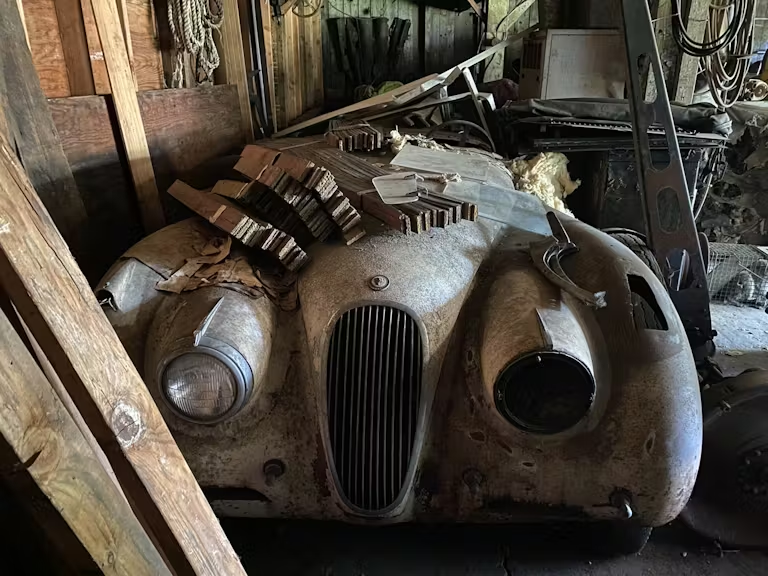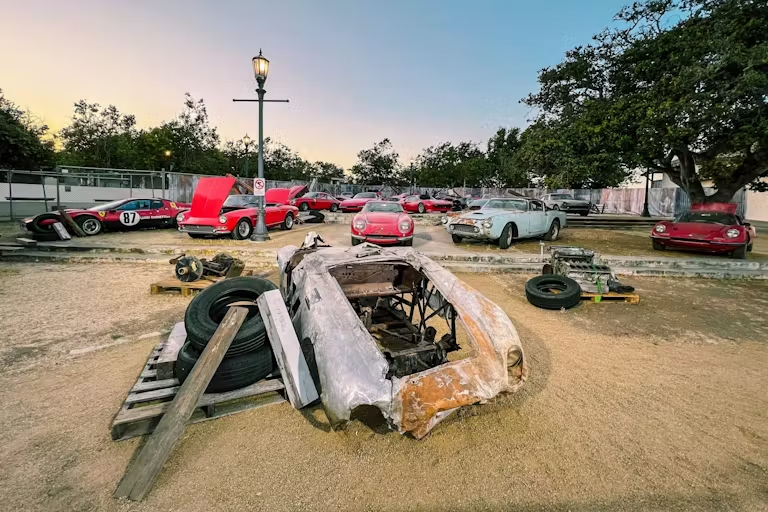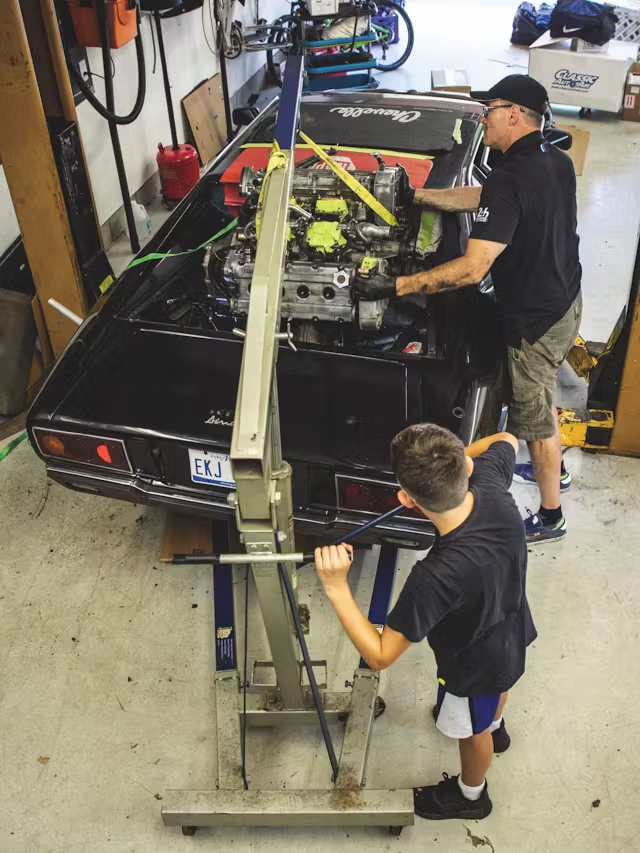If you’ve been in the car world for any length of time, you’ve surely heard terms like “barn find” or “survivor,” both of which can certainly be exciting. They’re as much artifacts as they are automobiles, offering a direct connection to a car’s creators and history that a gleaming restoration just can’t. You’ve probably had the daydream of swinging open a pair of rickety old wooden doors, seeing the light spill onto faded, dust-covered paint as your eyes adjust to your favorite historic Ferrari or long-lost Hemi Mopar.

This kind of automotive archaeology is our hobby’s version of Indiana Jones, Howard Carter discovering King Tut’s tomb, or those videos of people exploring abandoned buildings. There is a web series dedicated to uncovering barn finds, and an auction site dedicated to selling them.
Close observation of the market has revealed that barn finds and other unrestored but completely original cars have sometimes achieved astonishing prices—often far exceeding those of fully functional, road-ready examples. Their unique originality, provenance, and the allure of recent discovery have historically driven bidders to spend freely. However, data from the past year, along with insights from industry professionals, indicate that vehicles in rough or project condition are currently facing challenges in the collector car market. Shifting tastes and difficulties within the restoration industry raise the question of whether barn finds and project cars are now losing their appeal.
What’s a Barn Find?

The whole concept of a barn find comes thanks to humans’ ability to keep and neglect (and sometimes hoard) things, and automobiles’ ability to withstand that neglect. For all sorts of reasons, people have been shoving old cars into barns, garages, warehouses, basements, living rooms, or open fields all over the world for decades, and leaving them there for decades. Some of these cars turn into junk or get cannibalized for parts. Some turn out to be valuable and/or historically significant. Tom Cotter’s book The Cobra in the Barn came out in 2005. It, along with the internet and TV shows like Chasing Classic Cars, brought the term to a wider audience, along with the romance of finding one. It has since entered the automotive lexicon, and as the car hobby has matured, original, preserved classics have found greater appreciation. Many high-profile concours events, which are traditionally festivals of polished perfection, now have a “preservation” class.
Big auction sales have exposed barn finds, too, sometimes breaking out of automotive circles and into the mainstream press. In the mid-2000s, a Ferrari 166MM surfaced after 50 years outside in the Arizona desert. The car was a mess, but it had history with Juan Manuel Fangio, and the 166MM was the most important racing model in the company’s early history, so a collector paid over $1M for what was left of it. In 2009, a one-of-17 1937 Bugatti Type 57S Atalante coupe surfaced for auction in Paris. After selling new to the famous Earl Howe, a British doctor bought it in 1955, drove it until 1960, then laid it up in his garage, where it remained until his death in 2007. It sold for €3.4M (about $4.4M). Even 16 years later, it’s still among the most expensive classic Bugatti road cars ever sold.

Sometimes, barn finds yield multiple vehicles. The biggest example has to be the Roger Baillon collection, a group of five dozen European classics found decaying on a property in the French countryside. Multiple price records broke when the collection went to auction in 2015, and the two highlights were a one-of-four Maserati A6G/54 by Frua and a short-wheelbase Ferrari 250 GT California Spider, discovered hiding under a pile of magazines. The Maserati sold for €2,000,000 ($2.3M), while the Ferrari brought €16,300,000 ($18.4M). The price for the Ferrari was roughly $6M more than the model’s condition #1 (concours, or best in the world) value in our price guide at the time, and it is still the 25th-highest price anyone has ever paid for an automobile at auction.
There are dozens more examples of cars billed as barn finds (even if they aren’t barn finds, really) and presented in their as-discovered state, dust and all, capitalizing on the cachet and selling for staggeringly high prices.
More recently, a twisted hunk of Italian metal that used to be a 1954 Ferrari 500 Mondial, which had been crashed in the early 1960s and further damaged by Hurricane Charley in 2004, sold for $1.875M. Billed as part of the “Lost and Found” collection sold in Monterey in 2023, it was interesting enough to earn our “Sale of the Year” nod. Appraiser and Hagerty Price Guide publisher Dave Kinney aptly summed up the car, the sale, and indeed the allure of barn finds in general: “the idea of actually buying and restoring it? It sounds both stupid and savvy, impossible and life-affirming, wrong on every level yet just so right. It’s a moonshot, but also one with all the roadmaps firmly in place. It’s a picture of destruction, but also that of a path to redemption. It’s like an O. Henry story, a Dickens story, and a Hemingway story all wrapped up in an old Italian race car.”

While there’s no real dictionary definition, Kinney also distinguishes between what is a barn find and what is a survivor. “Survivor cars are well-preserved vehicles that are, in a sense, historical artifacts. Their preservation is impressive, and their originality is both rare and impossible to replicate, so they are highly desirable. They retain most of their original surfaces.” Barn finds, meanwhile, can be far more deteriorated or damaged, even incomplete cars missing major components. “A car can be both a barn find and a survivor, but few are.”
What’s Changing
Regardless of terminology, vehicles requiring extensive restoration or significant work are reportedly more difficult to sell today than in previous years, according to professionals within the industry. According to Kinney: “Every dealer that I talk to, without exception, says that if it’s not a perfect or damn-near perfect car, it’s having a hard time selling at any price.” For Jose Romero of dealer DriverSource in Houston: “It used to be we could buy a barn find/garage find type of car, and if we bought it right we knew a few guys we could sell it to as-is for a quick flip and be done, or we could prep and service and clean it, get the books and tools and all that stuff, and then really hit a home run with it. But now you can’t sell those kinds of cars in the current state they’re in anymore. Those buyers are gone.”
This observation aligns with a broader trend evident over the past two to three years, in which vehicles in excellent condition command increasingly higher premiums compared to lesser examples requiring work. Ten years ago, the average value difference in the Hagerty Price Guide between condition #2 (excellent) and condition #3 (good) vehicles was 22%. In 2020, the gap had grown to 25%. Today, it’s 33%. It’s a similar story for the gap between condition #3 and rougher cars in #4 (fair) condition. In 2015 it was 21%, and today it’s 32%.
For Greg Ingold, editor of the Hagerty Price Guide, “these widening gaps come down to buyer expectations, as ‘lesser’ cars are a harder sell and need to be priced appropriately to move.” Like Kinney, he has heard in his regular check-ins with dealers that “buyers are more and more demanding. If a car is anything less than absolutely functional and cosmetically sound, they can expect to lose the sale.”

An analysis of major North American auction events—Arizona, Amelia Island, and Monterey—where vehicles have been inspected and assigned condition ratings over the past decade, reveals an interesting shift. Historically, barn finds, survivor cars, and their accompanying stories have often resonated strongly with bidders. In 2025, however, only 33% of vehicles in #4 or #5 (project car) condition sold above their low estimates, marking the lowest percentage recorded since condition ratings began being tracked at these events.
Financially, buying a barn find or project car with major restoration in mind is often a terrible way to buy a car, especially when paying a big premium for that originality. Even if you embark on a mostly mechanical restoration and leave the patina alone for preservation purposes, there’s still extensive work from a specialist and expensive parts in the car’s future. Even if you happen to have the skills and tools to do the work yourself, there goes hundreds of hours of your own free time. Most classic cars also aren’t worth nearly as much as a freshly unearthed 300 SL Gullwing or Shelby Cobra, and never will be. Paying 30 grand for a car and then putting 80 grand into it so it will be worth 65 grand when it’s done is not something everyone can stomach.

Restorations are difficult, expensive, and time-consuming. With each passing year, restoration talent is getting harder to find, the work is getting pricier, and the wait lists are getting longer. Buying a total project was never for the faint of heart, but it’s more of an undertaking now than it ever has been. “Part of it is cultural, but people aren’t attempting projects,” says Kinney. “There’s the cost of all the supplies, including chrome, paint, and everything else, but the father-son or father-daughter restoration team, they’re just not out there anymore.”
For an older buyer, the idea of resurrecting a decrepit old car and then taking on the show and rally circuit might sound rewarding or even romantic, but the timeline of that resurrection is both long and ill-defined, and since none of us are guaranteed tomorrow, it’s much easier to buy a done car to enjoy right now while you still can.
There is also a glut of project cars out there. Look up any type of classic car for sale, and there are always at least a few non-runners in the mix. VanDerBrink Auctions seems to find a new barn, warehouse, or field full of crusty cars, trucks and/or motorcycles every other month. Bonhams also spent several years drip-feeding hundreds of long-dormant Aston Martins out of a collection in the Middle East onto the market. At this point, it seems that there are far more classic vehicles in need of saving than there are people willing to take them on.
Down But Not Out

It would be wrong to say that nobody wants project cars anymore. In the right setting, with the right audience, they can still sell at a premium. Late last year, a massive group of project cars in Los Angeles, literally billed as the late Rudi Klein’s “Junkyard” collection, went up for auction, and the sale was an undeniable success. The cars, former cars, and parts attracted bidders from nearly 40 countries. Among several world record prices and smashed expectations were an alloy-bodied Mercedes-Benz 300SL that broke the all-time auction record for the model at $9.355M and a Lamborghini Miura sold for nearly double its high estimate at $1.325M.
But with rougher vehicles becoming harder to sell and restorations becoming increasingly difficult, project cars face a tough future. If a car is perfectly restorable but nobody wants to go through all the hassle, it may get cannibalized for parts. Which is a shame, but it’s hard to imagine any of the trends outlined above reversing course.
Barn finds are not dead. The dust may have lost some of its magic. Major projects are harder to justify, and therefore, fewer people seem to be willing to take the plunge on a big restoration. That said, it’s a big world out there. There will always be tinkerers, so if barn finds and projects get cheaper, at least that makes for an easier point of entry.
Report by Andrew Newton
find more news here.










